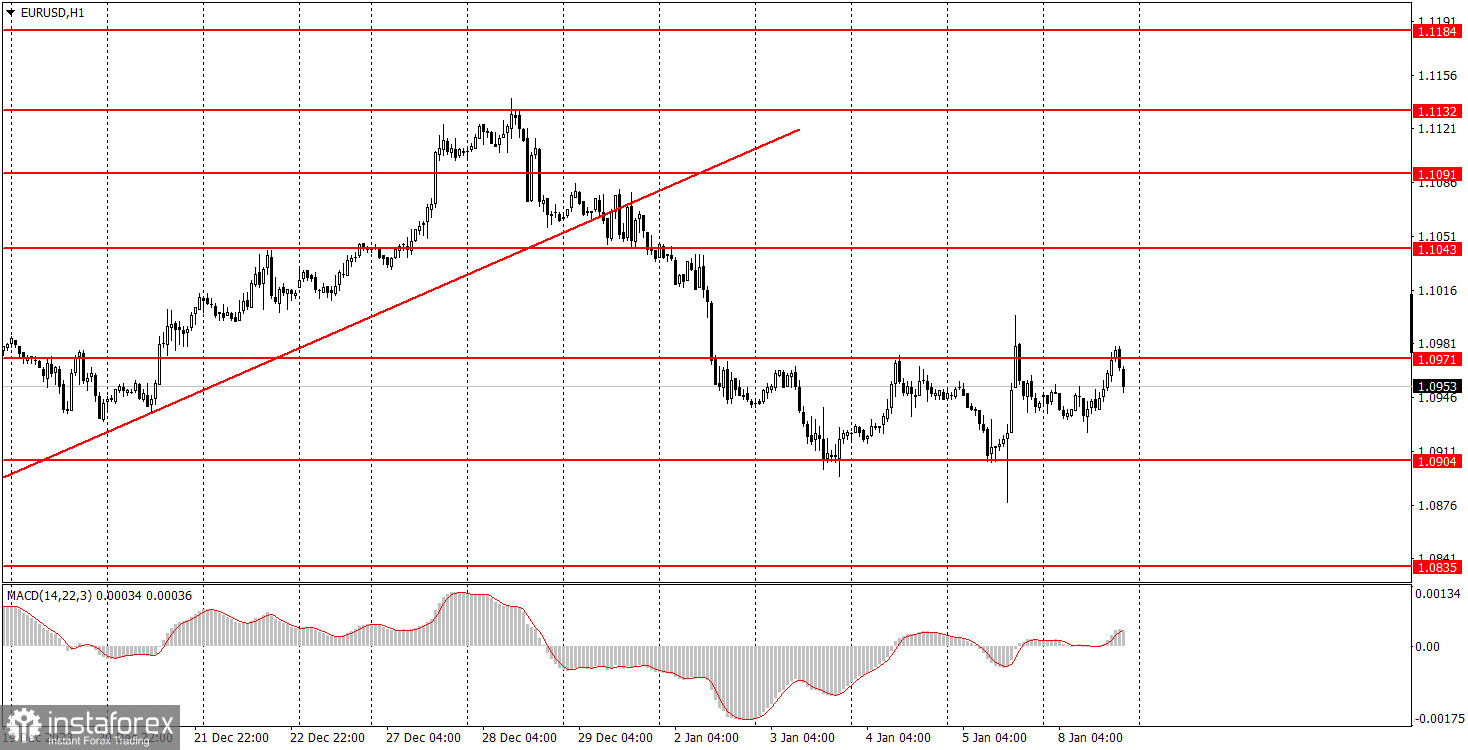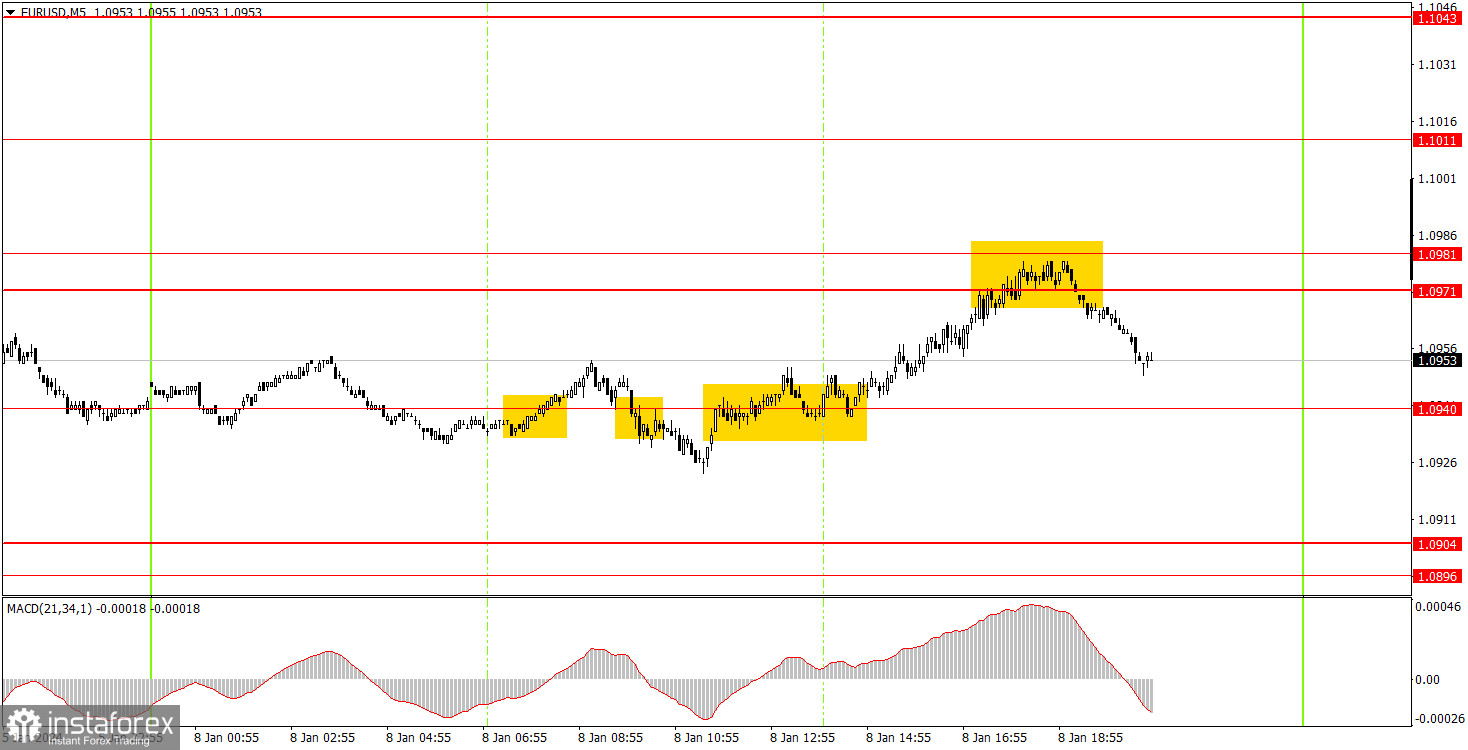Analyzing Monday's trades:
EUR/USD on 1H chart

EUR/USD showed relatively low volatility on Monday. Moving within a price range that it has been in for the past four days, from 1.0904 to 1.0971. By the end of the day, the upper band of this range was tested, so now we can expect the price to fall back to the level of 1.0904. As before, we believe that the uptrend has ended so now we expect a stronger decline from the euro.
There were no significant events on Monday. The eurozone retail sales report for November was published, and its value matched forecasts. Consequently, there was no significant market reaction to this report. Take note that the entire week is expected to be uneventful. The only important event we can highlight is the US inflation report on Thursday. In our opinion, the euro does not have any reasons to resume its uptrend. However, recently, the market has shown a lack of interest in buying the dollar. Therefore, in case the pair breaches the level of 1.0971, we could expect a new upward movement.
EUR/USD on 5M chart

Unfortunately, during the Asian and European trading sessions, there was an absolute flat, so the signals turned out to be false. The price crossed the level of 1.0940 three times and it only managed to hit the nearest target on the third attempt. However, the third signal should not have been executed since the first two were false. We already warned you that we shouldn't expect strong movements on Monday. Beginners could also execute the last sell signal, in the form of a bounce from the 1.0971-1.0981 area, and at the moment, the trade can be left open, setting a stop-loss at breakeven, since there is a high probability of the price falling back to the 1.0904 level.
Trading tips on Tuesday:
On the hourly chart, EUR/USD finally has a chance to form a downtrend. A plethora of important U.S. reports did not provide strong support for the greenback, but the downtrend persists. Perhaps the pair needs to start a minor bullish correction before it goes back to falling again, but for now, it has been in a flat phase for four days.
We will be guided by the range of 1.0904-1.0971. Currently, there has been a bounce from the upper band of this channel, so we can expect the price to fall to the lower band. Moreover, there are very few significant events this week, so the market may move the pair solely based on technical factors. We are considering selling on Tuesday.
The key levels on the 5M chart are 1.0733, 1.0767-1.0781, 1.0835, 1.0896-1.0904, 1.0940, 1.0971-1.0981, 1.1011, 1.1043, 1.1091, 1.1132-1.1145, 1.1184, 1.1241, 1.1279-1.1292. On Tuesday, Germany will release a report on industrial production and the eurozone unemployment rate will be published. Both reports are relatively minor, and volatility could be low again.
Basic trading rules:
1) Signal strength is determined by the time taken for its formation (either a bounce or level breach). A shorter formation time indicates a stronger signal.
2) If two or more trades around a certain level are initiated based on false signals, subsequent signals from that level should be disregarded.
3) In a flat market, any currency pair can produce multiple false signals or none at all. In any case, the flat trend is not the best condition for trading.
4) Trading activities are confined between the onset of the European session and mid-way through the U.S. session, after which all open trades should be manually closed.
5) On the 30-minute timeframe, trades based on MACD signals are only advisable amidst substantial volatility and an established trend, confirmed either by a trendline or trend channel.
6) If two levels lie closely together (ranging from 5 to 15 pips apart), they should be considered as a support or resistance zone.
How to read charts:
Support and Resistance price levels can serve as targets when buying or selling. You can place Take Profit levels near them.
Red lines represent channels or trend lines, depicting the current market trend and indicating the preferable trading direction.
The MACD(14,22,3) indicator, encompassing both the histogram and signal line, acts as an auxiliary tool and can also be used as a signal source.
Significant speeches and reports (always noted in the news calendar) can profoundly influence the price dynamics. Hence, trading during their release calls for heightened caution. It may be reasonable to exit the market to prevent abrupt price reversals against the prevailing trend.
Beginning traders should always remember that not every trade will yield profit. Establishing a clear strategy coupled with sound money management is the cornerstone of sustained trading success.
 English
English 
 Русский
Русский Bahasa Indonesia
Bahasa Indonesia Bahasa Malay
Bahasa Malay ไทย
ไทย Español
Español Deutsch
Deutsch Български
Български Français
Français Tiếng Việt
Tiếng Việt 中文
中文 বাংলা
বাংলা हिन्दी
हिन्दी Čeština
Čeština Українська
Українська Română
Română

